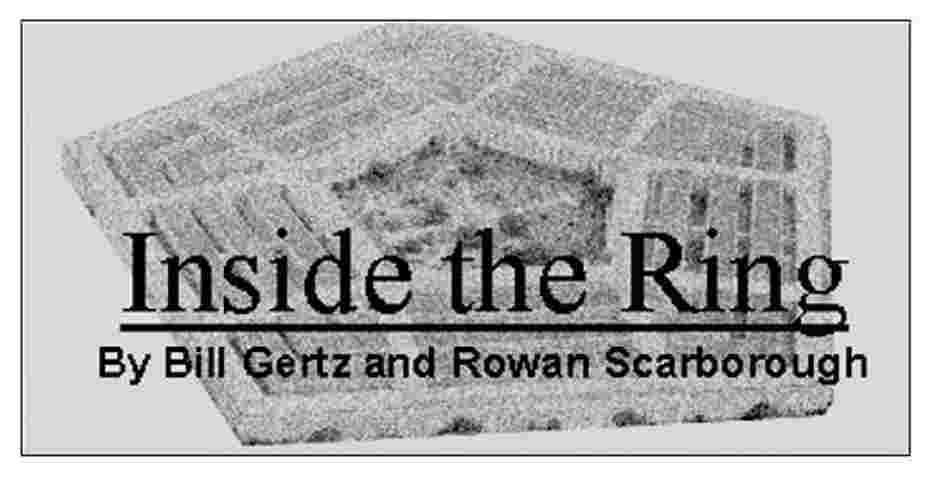|
Return to
|

|
April 18, 2003
Notes from the Pentagon
Market bombings
The conclusion is based on more than the oddity that two markets happened to be bombed during business hours within two days of each other. The Sha'ab Market exploded March 26, the Nasser on March 28. The conclusion also goes beyond the fact that the United States picked up intelligence reports before the war that the Ba'ath Party planned to bomb Shi'ite neighborhoods and blame it on the allies.
The command has studied a wide variety of satellite images of the markets, before and after the explosions. The damage is inconsistent with either a Tomahawk missile or a 2,000-pound satellite-guided bomb that were sent to Baghdad during that time. Instead, the damage is consistent with a homemade bomb and a small munition.
"We do not believe we did that," said a senior allied officer. "The supposition now is that it was self-inflicted as a propaganda thing. They blew up a bomb in their market for propaganda."
The officer said commanders have looked at aircraft sorties that day over Baghdad and believe they can account for every dispensed munition.
"The images that we have looked at of the damage looks more like a garden variety car bomb," said the officer. "Both markets had bomb signatures that did not look like death from above."
CAOC update
The Air Force told us at the time that the problems were being fixed.
Operation Iraqi Freedom seemed to prove the point. The center managed one of the most intricate air wars ever. Early statistics indicate few munitions went astray. Only one fixed-wing aircraft was definitely shot down by hostile fire — an A-10 Thunderbolt flying close-air support over Baghdad in the war's final days.
The Saudis are politically sensitive about their role in the war. They did not allow their airstrips to launch strike missions.
But they were relatively open about the fact that the CAOC hosted the air war nerve center. No reporters were allowed, but Brig. Gen. Ron Rand, the Air Force's chief spokesman, set up camp at Prince Sultan base and sent out press releases noting specific bombing missions. Lt. Gen. T. Michael Moseley, Central Command's top air boss, held a video press conference from the base, giving it more exposure.
On April 2, the Air Force issued talking points to officers to educate them.
"The CAOC is a modern weapon system that gives the Combined Forces Air Component Commander a powerful and unique C2 [command and control] asymmetric advantage over the Iraqi regime and military," the "Aim Points" handout says.
Clarke leaving?
Variety.com, quoting music industry insiders, said Mrs. Clarke is on the top of the association's wish list to take over from Chairman Hilary Rosen. Mrs. Rosen said Mrs. Clarke is not an official candidate but noted that "any organization would be lucky to have her."
Mrs. Clarke, a former public relations executive and press aide to Sen. John McCain, Arizona Republican, has spent the past two years as the Pentagon's top spokeswoman.
She has won praise for revolutionizing the way the press covers a war. In Desert Storm, reporters with the troops were subjected to an odious censorship process. In Operation Iraqi Freedom, Mrs. Clarke injected combat units with hundreds of embedded reporters, who were free to report what they saw via satellite on the spot. The public got to see the invasion of Baghdad as it happened one Friday night on Fox News. The ground rules were simple: Don't report on future plans.
Asked if she plans to leave the post, Mrs. Clarke told us: "I hope to stay as long as the president and secretary think it is a good idea to do so."
Speicher update
Cindy A. Laquidara, the spokeswoman, said all the Pentagon will say about the case is that it is still looking in Iraq for people or documents that may shed light on the case.
"The search for Scott is more deserving of staffing than the search for weapons of mass destruction," Mrs. Laquidara said. "It's more time-critical, and it's a great debt that we have to our servicemen.
"We're asking it be given the highest priority," she said.
Asked about the hunt for Capt. Speicher, Defense Secretary Donald H. Rumsfeld said earlier this week: "If and when we have anything to announce, we will. We, needless to say, have teams of people who have very much focused on the question of prisoners of war."
Mr. Rumsfeld said there has been "some good success thus far" and that "we are working on the problems and hoping that we'll have success."
Capt. Speicher was declared killed in action in January 1991 after his F-18 was shot down over Baghdad. After intelligence reports indicated he survived the shootdown, he was reclassified twice, the final time to "missing-captured."
Diego bombers
The B-2 was not around for Desert Storm, nor was much of the Navy's and Air Force's ability to drop precision-guided weapons. That put tremendous pressure on air planners to husband resources. Only the F-117 stealth bomber could penetrate downtown Baghdad in the early days.
But in Operation Iraqi Freedom, the B-2 stealth bomber allowed planners to send massive firepower over the capital from the first night of the conflict.
Palace paper
"Gold-plated bathrooms are nice, but the toilet paper is not up to our standards," the officer said.
|
|
Inside the Ring Archives
1999 Columns 2000 Columns 2001 Columns 2002 Columns 2003 Columns |